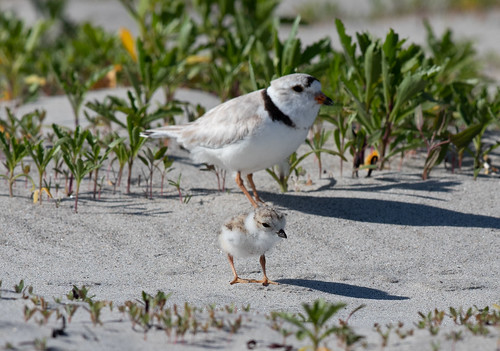Last year’s pandemic had at least one bright side, at least for birds. Many beaches and other public gathering places were closed, giving birds a rare respite from dealing with people and our dogs. This was very important for one of my favorite birds on the planet, the Piping Plover.
The two little plovers who, in 2019, started nesting in Chicago got a lot of protection from caring Chicagoans when they set up housekeeping on Montrose Beach. People started calling the birds Monty and Rose. The city sent a music festival elsewhere to reduce pressure on the tiny beach birds, who managed to fledge two chicks that year despite several close calls. And last year they successfully brought off three more chicks.
Because these birds have been banded with both aluminum USGS leg bands and colored bands, they can be recognized individually from quite a distance. This is how we know that Monty wintered in on Bolivar Flats in Texas and Rose at Anclote Key Preserve State Park in Florida. They may have taken separate vacations, but they both returned to Montrose Beach again this April.
But in early June, Monty and Rose lost all four eggs of their first clutch to a skunk. A special fence called an exclosure, designed to protect plover nests, had been erected, but welding on a wire junction failed and the skunk managed to reach through to the eggs. A motion-activated camera caught the tragedy.
 |
| Piping Plover safely nesting within an exclosure on a Maine beach |
Birds often have to deal with setbacks and losses. Just six days later, Rose produced another egg, and now the pair has a full clutch of four eggs which should hatch in mid-July.
Monty and Rose are the first Piping Plovers to attempt to nest, much less succeed, in Chicago since 1955. If this weren't wonderful enough, these two splendid birds are also responsible for another historical first. It’s been 83 years, since the Great Depression, since Piping Plovers nested in Ohio, but this year a pair turned up on Maumee Bay in Ohio, laid four eggs, and are now incubating them. And the male of this pair just happens to be Nish, one of Monty and Rose’s chicks from last year. The female, nicknamed Nellie, was hatched at Presque Isle in Erie, Pennsylvania. All the efforts made by the City of Chicago and its parks department, Chicago Audubon, and the army of volunteers out there protecting Monty and Rose get a lot of the credit, too.
 |
| Rose and one of the 2019 chicks. Photo copyright 2021 by Susan Szeszol. |
This year there are somewhere between 60 and 80 pairs of Piping Plovers on the Great Lakes. Because the population is growing where the birds are protected, we could get them back on Park Point here in Duluth if only Duluthians could keep dogs off the beach during spring migration. But based on how rudely I’ve been treated when I remind people of the city ordinances against running dogs off-leash on city property, I’m afraid Duluth will never catch up to Chicago or Toledo in our conservation ethics.
Just as exciting as the news of the Illinois and Ohio Piping Plovers is the news out of Maine. Back in 1981 when Maine Audubon counted Piping Plovers nesting on the state’s beaches, they found only 10 pairs. This spring, 120 nesting pairs were counted—not only the largest number ever counted in the state but the first time the number exceeded 100.
I’m extraordinarily fond of Maine’s Piping Plovers because I’ve spent so much time watching them. I loved them plenty enough after seeing them several times in May and June on Popham Beach, but then in June 2019, my friend Laurie Gilman brought me to several beaches where the chicks had hatched. Adult Piping Plovers are wondrously adorable, and there are no words to capture the cosmic adorableness of their fuzzy chicks.
Dr. Seuss’s Lorax said, “Unless someone like you cares a whole awful lot, nothing is going to get better. It’s not.” The great success of Piping Plovers right now bears testament to the profound truth of just how effective conservation measures can be, when people care.

